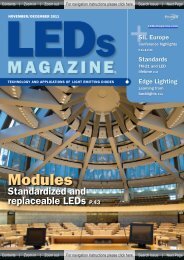LED Applications & Lighting Systems - fonarevka
LED Applications & Lighting Systems - fonarevka
LED Applications & Lighting Systems - fonarevka
Create successful ePaper yourself
Turn your PDF publications into a flip-book with our unique Google optimized e-Paper software.
Copyright © 2009 Luger Research & <strong>LED</strong>-professional. All rights reserved.<br />
For adaptive lighting, all circuits can use the maximum light variation<br />
with all parameters (0-100 %) and in any combination except the two<br />
circuits for the direct lighting (table light). A single circuit for direct light<br />
has a maximum of 80 % and both circuits together have a maximum of<br />
120 %. To obtain a smooth change, light variation must not exceed 10%<br />
per second. Indirect lights are mounted along the whole length of all<br />
four sides of the room. The direct light, i.e. the table lamp, produces a<br />
great deal of heat, which is why a fan has been added. A bus box<br />
contains all the interfaces that are usually included in the building<br />
automation system. The light sensor is attached to the table light and<br />
normally directed to a window to check the amount of daylight.<br />
The applications have been implemented in Java. However, given the<br />
above-described approach it would be possible to implement other<br />
individual applications using different programming languages if Java<br />
should prove inappropriate for any particular application. Client and<br />
server communicate via a specially developed ALADIN protocol at the<br />
application level. This means that the client application can instruct the<br />
server application to start or terminate recording, to store the results or<br />
retrieve records already stored.<br />
Each application can store data (e.g. biosignal results) in the persistence<br />
layer. All data are saved as plain text into a directory, the name of which<br />
records time and date. What is difficult with this type of implementation<br />
is the performance of complex queries combining different search<br />
parameters. If this should be required in the future, it can be realized<br />
due to the abstraction of storage mechanisms provided by the<br />
persistence level which allows easy integration of a database.<br />
Figure 5: Software architecture of ALADIN<br />
Figure 4: ALADIN light installation<br />
Software architecture<br />
It is essential that the software architecture of ALADIN be open to allow<br />
easy integration with other information and communication systems in<br />
buildings, thus becoming part of a general assistive environment. For<br />
this reason ALADIN is a platform-independent system which can run on<br />
any supported operating system platform.<br />
ALADIN has a client-server computing architecture, where the applications<br />
are clients who may initiate a communication session (see Figure 2). Each<br />
of these applications has a user interface and an application area. Data<br />
between client and server are exchanged via TCP/IP.<br />
ALADIN applications<br />
For automatic light adaptation the user has to select either an activating<br />
or a relaxing light situation. According to the user’s selection the adaptive<br />
algorithm (e.g. simulated annealing or genetic algorithm) starts looking<br />
for the best individual lighting condition. Before starting the light<br />
adaptation the light sensor checks the amount of daylight within the<br />
room. The user receives the information to darken the room if it is too<br />
bright for adaptive lighting. The automatic light adaptation is achieved by<br />
an open loop circuit modifying the light parameters through the DALI<br />
interface and interpreting the biosignals (electrodermal activity and heart<br />
rate) measured by the biosensor glove as an individual reaction to these<br />
light modifications. The result of this interpretation is used by the adaptive<br />
algorithms to find the next best light modification. The intelligent control<br />
loop is started manually by TV remote control and stopped manually by<br />
the user or automatically when the user leaves the room.<br />
After selecting the manual light option in the main menu, the user is<br />
offered different options of light situations on the television screen. The<br />
user can select one of these options. There are several predefined<br />
www.led-professional.com <strong>LED</strong> professional Review | Mar/Apr 2009 | page 24

















